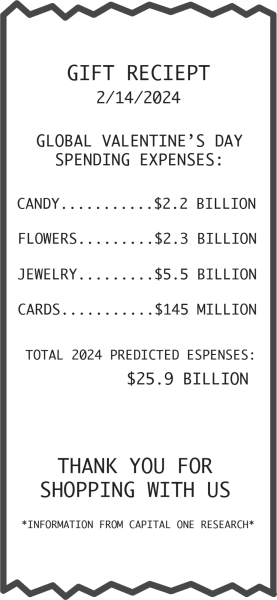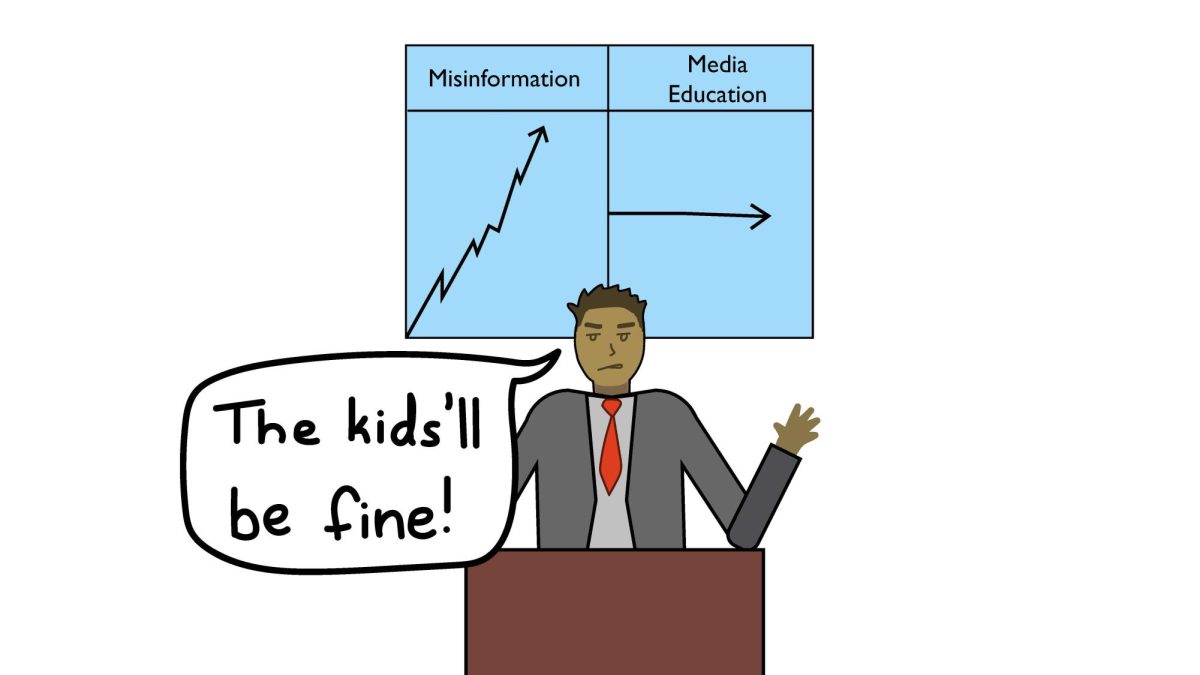Last year, Americans spent nearly $1 trillion on holiday gifts during the winter months, according to CNBC, and this number is only going to rise. Holidays often call for gift giving, and this sudden increase in compulsory buying is feeding the global issue of consumerism, which is characterized by excessive spending. As Valentine’s Day approaches, it’s important to be aware of our spending habits. From heart-shaped candy to jewelry, this extreme holiday-driven consumerism is proving to have lasting effects on the environment and people’s relationships with materialistic gift giving.
Valentine’s Day is the second largest materialistic holiday and is a massive contributor to consumerism. Globally, the National Retail Federation expects shoppers to spend over $25.7 billion on Valentine’s gifts this year, with an average of $193 per consumer. In particular, the holiday has made the public a victim of obligatory consumerism — the idea of “having” to buy something for a friend, family member or significant other. Spending is driven by the unhealthy yet prevalent idea that love is determined by material things and can only be displayed by the monetary value of a gift, putting tremendous value on product consumption. Those in romantic relationships suffer the most from obligatory consumerism since they may feel more compelled to shower their partner with gifts. Valentine’s Day is intended to be an opportunity for loved ones to feel cared for, but this can be achieved without spending hundreds at a local CVS on low quality items.

Before Valentine’s Day, most companies create seasonal editions of their regular products, usually no different than a slight design change, and label them as “limited holiday edition” to increase sales revenue. Consumers often buy the holiday edition product even if they don’t need it, spurred by a commonly used marketing strategy called the Scarcity Principle.
The Scarcity Principle is a psychological method used to increase value in a product by releasing smaller quantities of it. In order to trigger the fear of being unable to own a particular product, companies release a limited number of items without restocking. This includes Valentine’s Day single-use decorations, clothing lines and dollar store specialties that add to landfills after the holiday passes.
A recent example of the Scarcity Principle and its severe environmental impact is the Valentine’s Day Stanley Tumbler that’s sold exclusively at Target. This limited edition pink-and-red tumbler has ignited a nationwide craze as it flies off the shelves, further demonstrating the influence that companies have over the psychology of human consumerism. The new Valentine’s Day color influenced many buyers to impulsively purchase it due to the product’s low stock. Stanley fueled the craze by stating that the tumbler would not be restocked, so it’s no wonder that Target had to limit customers to two cups per person. Not only does this defy the entire point of owning a reusable cup, but it just showcases and reinforces how susceptible people become to consumerism during the holiday season.
By 2030, the global consumerist class — a percent of the population that is able to comfortably spend about $10 a day — will rise from 3.5 billion to 5.6 billion people, according to the Brookings Press. The consumerist class has increased by 110 million every year for the past two decades. For companies to keep up with the growing numbers of consumers, manufacturers are speeding up the production process, which emits more carbon dioxide into the atmosphere. From 2020 to 2023, global carbon dioxide emissions have risen from 35.01 billion metric tons to 37.55 billion metric tons according to Statista, and this is significantly contributing to global climate change. The US is the second highest emitter due to product manufacturing in the world, just behind China, and the US remains the biggest carbon polluter in history. On top of air pollution, higher consumption produces enormous amounts of physical waste from product packaging, and landfills are filling up quicker with thrown out items. Holidays, like Valentine’s Day, that center around gift giving increase consumption and normalize these rates as a concerning number of gifts are bought. Between the increased carbon emissions and copious waste produced by holiday shopping, the earth is becoming more and more polluted. Although it is easy to conform to the trend of unnecessary holiday consumption, now is the time to reflect on its environmental consequences and decrease individual product consumption by making more environmentally-friendly gift giving choices.
The question is: how can we combat consumerism, especially during Valentine’s Day? The answer is complicated, but there are many ways to individually decrease consumption. Holidays can still be celebrated without excessive spending, especially since handmade items can be more meaningful than store-bought chocolates and socks. Try baking a cake, making a card or planning a hike with your loved one. At the end of the day, it truly is the thought that counts. This February, take a break from consumerism. Your wallet and, more importantly, the Earth, will thank you.











Marty Salina • Feb 13, 2024 at 1:09 PM
We don’t need AI, we just need more human intelligence as expressed in this article, very interesting.
J. Mraz • Feb 13, 2024 at 12:34 PM
Very well written article by Ava Hedin. Makes one stop and think.